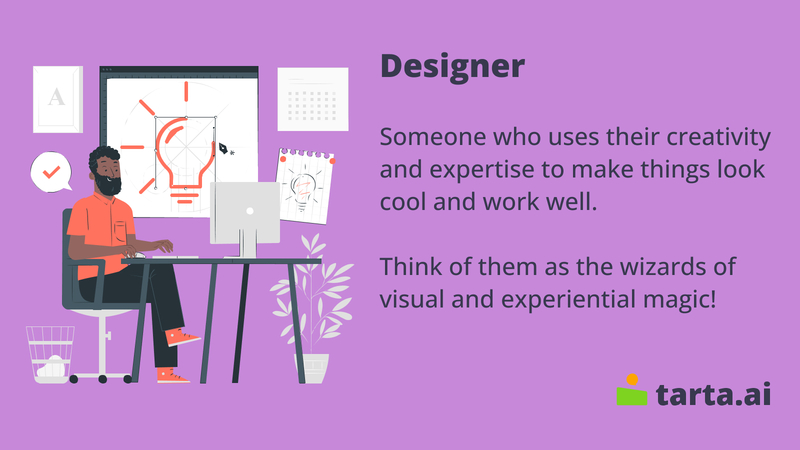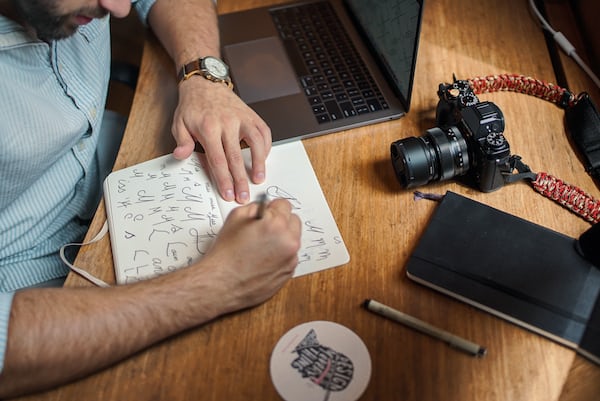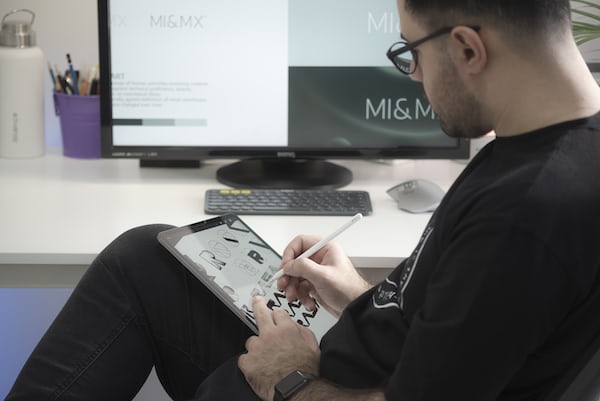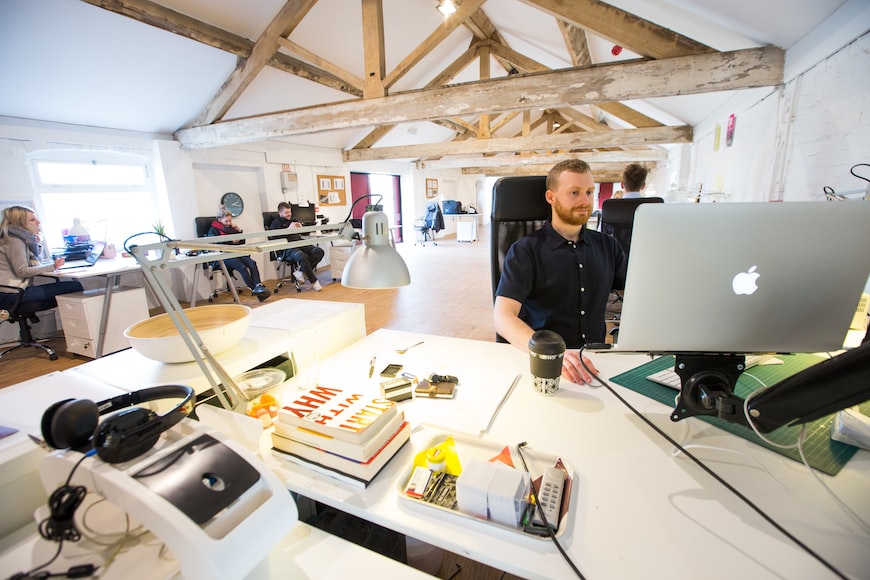The Complete Guide to a Career in Design: Education, Skills, and Career Paths

The field of design encompasses a wide range of creative disciplines, from graphic design to industrial design, web design, and more. Designers play a crucial role in society, using their creativity, skills, and technical knowledge to create visually appealing and functional solutions that meet a variety of needs. They work in various industries and fields, from advertising and marketing to technology, healthcare, and education. Designers are in high demand, with businesses recognizing the importance of design in creating successful products and brands. However, the job of a designer can be both rewarding and challenging, requiring a combination of hard and soft skills to be successful.
This article will explore the field of design, its subfields, career development opportunities, and challenges designers face, as well as the government programs in the US that can assist designers in advancing their careers.
1.Job description
A designer is a professional who uses their creative and technical skills to develop and execute visual concepts and designs for various purposes. They can work in a variety of industries, such as graphic design, fashion design, interior design, industrial design, and web design.

Designers typically work closely with clients or stakeholders to understand their needs and goals, and then create designs that effectively communicate the desired message or function. They may use various tools and techniques such as sketches, computer software, 3D modeling, and prototyping to develop and refine their designs.
Requirements
The general requirements to become a designer usually include:
- Education and Training: Many designers have a bachelor's degree in a related field such as graphic design, industrial design, fashion design, or interior design. Some designers may also have a master's degree. Additionally, it is common for designers to participate in training programs, workshops, and other learning opportunities to stay up-to-date on the latest trends and technologies in their field.
- Portfolio: A portfolio is a collection of a designer's work that showcases their skills, abilities, and design style. Having a strong portfolio is essential for designers to demonstrate their abilities to potential clients or employers.
- Technical Skills: Designers must have a strong understanding of the software and tools used in their field. For example, graphic designers may use Adobe Creative Suite, while industrial designers may use 3D modeling software such as SolidWorks.
- Creativity and Aesthetics: Designers must have a strong sense of creativity and an eye for aesthetics. They must be able to develop unique and visually appealing designs that effectively communicate the desired message or function.
- Communication and Collaboration Skills: Designers must be able to communicate effectively with clients, stakeholders, and team members. They must be able to listen to feedback, ask questions, and collaborate with others to ensure that the final design meets the client's needs and goals.
- Business Skills: Many designers work as freelancers or run their own design businesses, so it is important for them to have business skills such as marketing, budgeting, and project management.
Tip:
Building relationships with other designers and professionals in your industry can help you learn about new job opportunities and gain valuable insights about the industry.
Duties and responsibilities
The main responsibilities of a designer can vary depending on their specific field and the project they are working on. However, some common responsibilities of a designer include:
- Understanding client requirements: Designers must understand the needs and goals of their clients or stakeholders to develop designs that meet their expectations. This may involve conducting research, analyzing user needs, and defining project objectives.
- Creating visual concepts: Designers develop visual concepts that effectively communicate the desired message or function. They may use various tools such as sketches, computer software, 3D modeling, and prototyping to create and refine their designs.
- Selecting materials and techniques: Depending on the project, designers may need to select materials and techniques that are appropriate for the design. For example, a fashion designer may need to choose fabrics and patterns that are suitable for a specific garment.
- Presenting designs: Designers must be able to present their designs to clients or stakeholders in a clear and compelling way. This may involve creating presentations, mood boards, or other visual aids to communicate their ideas.
- Collaborating with team members: Designers often work as part of a team, so they must be able to collaborate effectively with other designers, project managers, and other team members. This may involve communicating design decisions, sharing feedback, and working together to ensure that the final design meets the client's needs and goals.
- Revising designs: Designers may need to revise their designs based on feedback from clients or stakeholders. This may involve making changes to the design concept, selecting different materials or techniques, or making adjustments to the final product.
- Keeping up-to-date with industry trends and technologies: Designers must stay up-to-date with the latest trends and technologies in their field to remain competitive and to continue to develop their skills and abilities. This may involve attending conferences, workshops, or other training opportunities.
In addition to the main responsibilities mentioned earlier, some designers may have additional duties depending on their specific field and the nature of their work. These additional duties may include:
- Managing projects: Some designers may be responsible for managing the entire design project from start to finish. This may involve creating project timelines, setting deadlines, and coordinating with team members and external stakeholders.
- Conducting market research: Designers may need to conduct market research to understand industry trends and consumer preferences. This information can help designers to create designs that meet the needs of their clients or stakeholders.
- Developing brand identities: Graphic designers may be responsible for developing brand identities for their clients. This involves creating a visual identity that represents the values and personality of the brand.
- Creating marketing materials: Designers may be responsible for creating marketing materials such as brochures, flyers, and social media posts. These materials are designed to promote the products or services of their clients.
- Testing designs: Some designers may need to test their designs to ensure that they are functional, user-friendly, and meet the needs of the target audience. This may involve conducting user testing or creating prototypes to test the design.
- Managing budgets: Designers who work as freelancers or run their own design businesses may be responsible for managing budgets and finances. This involves setting prices for their services, creating invoices, and managing expenses.
- Maintaining client relationships: Designers must maintain good relationships with their clients to ensure repeat business and positive referrals. This may involve providing ongoing support and guidance, responding to client feedback, and providing regular updates on the project.
Hard and soft skills
Designers require a combination of hard skills and soft skills to be successful in their roles. Hard skills are specific, technical skills that are necessary to perform a particular job, while soft skills are personal traits and characteristics that enable individuals to work well with others and effectively manage their work.
Hard skills | Soft skills |
Proficiency in design software and tools Designers need to have a strong knowledge of the software and tools used in their field. For example, graphic designers may need to know Adobe Creative Suite, while web designers may need to know HTML and CSS. | Creativity and imagination Designers need to be creative and imaginative to come up with new and innovative designs that meet the needs of their clients or stakeholders. |
Knowledge of design principles and elements Designers must have a good understanding of design principles and elements, such as color theory, typography, layout, and composition. | Communication and collaboration Designers need to be able to communicate effectively with clients, stakeholders, and team members. They must be able to listen to feedback, ask questions, and collaborate with others to ensure that the final design meets the client's needs and goals. |
Technical knowledge Depending on the field of design, designers may need to have technical knowledge related to materials, production processes, or manufacturing. | Attention to detail Designers must have a keen eye for detail and be able to focus on the small details that can make a big difference in the final design. |
3D modeling and prototyping Industrial designers and product designers may require 3D modeling and prototyping skills to bring their designs to life. | Time management and organization Designers must be able to manage their time effectively and prioritize tasks to meet project deadlines. |
Problem-solving and critical thinking Designers must be able to think creatively and come up with solutions to design problems that meet the needs of their clients or stakeholders | |
Adaptability and flexibility Designers must be able to adapt to changing project requirements or client needs and be flexible enough to adjust their designs accordingly. |
2. Salary
The salary of a designer in the US can vary widely depending on several factors such as their experience, industry, location, and specific design specialization. However, as a general guideline, junior designers can expect to earn around $30,000 - $50,000, mid-level designers can earn around $50,000 - $100,000, and senior designers can earn around $100,000 - $150,000.
Ways to improve earnings
There are several ways designers can improve their earnings:
- Expand your skill set: Learning new design skills can help you take on more complex projects and potentially increase your earning potential. For example, if you are a graphic designer, learning UX/UI design can help you become more valuable to employers and command higher salaries.
- Seek out new opportunities: Staying up to date on job postings and networking with other professionals in your industry can help you find new job opportunities that offer higher salaries.
- Negotiate salary: When negotiating a job offer or a raise, it's important to be confident in your skills and the value you bring to the company. Research the industry standards for your position and be prepared to explain why you deserve a higher salary.
- Work for higher-paying industries: Certain industries such as technology or healthcare tend to pay higher salaries for designers compared to others, so it may be worth seeking out opportunities in these fields.
- Start your own business: Starting your own design business can give you more control over your earnings, as you can set your own rates and take on as much work as you can handle.
- Specialize in a high-demand area: Certain areas of design, such as UX/UI or product design, are currently in high demand, and designers with expertise in these areas may be able to command higher salaries.
Remember, earning potential is influenced by a variety of factors, so it's important to stay informed about industry trends, network with other professionals, and continuously improve your skills to maximize your earnings.
Additional benefits
In addition to salary, there are many benefits that designers can receive as part of their compensation package, such as:
- Health insurance: Many companies offer health insurance benefits to full-time employees, which can help cover the cost of medical expenses and improve overall health and wellbeing.
- Retirement plans: Some companies offer retirement plans, such as 401(k)s, to help employees save for retirement and ensure financial stability in the future.
- Paid time off: Paid time off (PTO) can include vacation days, sick days, and holidays, and can help employees maintain a healthy work-life balance.
- Flexible work arrangements: Some companies offer flexible work arrangements, such as remote work or flexible hours, which can help employees achieve a better work-life balance and reduce commuting time and expenses.
- Professional development opportunities: Some companies offer opportunities for professional development, such as training, conferences, or tuition reimbursement, which can help designers improve their skills and advance their careers.
- Employee discounts: Some companies offer discounts on their products or services to employees, which can help reduce expenses and improve overall financial wellbeing.
Overall, these additional benefits can add significant value to a designer's compensation package, and it's important to consider them when evaluating job offers and negotiating salaries.
Remember, earning potential is influenced by many factors, and it's important to continuously work on improving your skills and seeking out new opportunities to maximize your earnings.
3. Job environment
A designer's job environment can significantly impact their creativity, productivity, and job satisfaction. A well-equipped workspace, proper software and tools, a collaborative atmosphere, flexibility, inspiration, and supportive management are crucial factors for a designer's success. In this section, we will explore the common job environment settings and tools used by designers to ensure they have the ideal work environment to unleash their creativity and deliver high-quality work.

Photo: Brad Neathery/Unsplash
As a designer, it is important to work in an environment that allows for creativity and productivity. Here are some recommended job environment settings for designers:
- A comfortable workspace: A comfortable and well-lit workspace with a good ergonomic chair and desk can help you stay focused and avoid physical strain while working for long periods.
- Proper software and tools: Make sure you have the proper software and tools needed to complete your work efficiently. This includes design software, drawing tablets, printers, and any other equipment required for your specific design work.
- Collaborative atmosphere: Designers often work in teams, so having an environment that fosters collaboration and communication is important. This can be achieved through regular team meetings, open communication channels, and a shared understanding of the project goals.
- Flexibility: A job environment that allows for flexible working hours and remote work can help you balance your work and personal life. It also enables you to work during your most productive times of the day, which can help you produce better quality work.
- Inspiration: Being in an environment that inspires creativity can help you come up with unique and innovative design ideas. This can be achieved through exposure to art, music, nature, and other sources of inspiration.
- Supportive management: Having supportive management who understands the challenges of design work and provides constructive feedback can help you improve your skills and feel more confident in your work.
Fact:
Studies show that a well-designed workspace can improve productivity by up to 20%.
Overall, the ideal job environment for a designer should be one that allows for creativity, productivity, and growth.
The tools and technologies used by designers vary depending on their specific field, but here are some commonly used ones:
Tool | Description |
Adobe Creative Suite | Adobe Creative Suite is a collection of graphic design, video editing, and web development software applications. The suite includes tools such as Photoshop, Illustrator, InDesign, and Premiere Pro. |
Sketch | Sketch is a vector graphics editor for digital designers. It is primarily used for creating user interfaces, web design, and mobile apps. |
Figma | Figma is a web-based design tool that allows designers to collaborate and create designs in real-time. It is primarily used for designing user interfaces, web design, and mobile apps. |
InVision | InVision is a prototyping and design collaboration tool. It allows designers to create and share interactive prototypes, animations, and designs. |
Canva | Canva is a user-friendly graphic design tool that allows non-designers to create professional-looking designs for social media, marketing materials, and presentations. |
HTML/CSS | HTML (Hypertext Markup Language) and CSS (Cascading Style Sheets) are the building blocks of web design. They are used to create and style the content of web pages.
|
JavaScript | JavaScript is a programming language used to create interactive web pages and web applications. It is commonly used in web design to create animations and add interactivity to web pages. |
Responsive Design | Responsive design is a web design technique that allows web pages to adjust to different screen sizes and devices. It ensures that web pages look good and function properly on desktop computers, tablets, and mobile devices. |
UX/UI Design | UX/UI (User Experience/User Interface) design is the process of creating user-friendly interfaces for websites, applications, and other digital products. It involves researching user behavior, designing user flows, and creating wireframes and prototypes. |
Overall, designers use a variety of tools and technologies to create visually appealing and functional designs for various mediums.
4. Education
If you're interested in pursuing a career in design, there are several education paths you can take. Here are some of the most common:
- Bachelor's degree in design
Many universities offer Bachelor's degrees in various design disciplines, such as graphic design, interior design, industrial design, fashion design, and more. These programs usually take four years to complete and cover a broad range of design principles, techniques, and software applications.
- Associate degree in design
Associate degree programs are often offered at community colleges or technical schools and typically take two years to complete. They offer a more focused education on specific design skills and software applications.
- Design bootcamps
Bootcamps are intensive, short-term programs that offer hands-on training in specific design skills or software applications. They can be a great option for people who want to quickly gain skills and knowledge in a particular area of design.
- Online courses and tutorials
There are many online resources available for learning design, including courses and tutorials on websites like Udemy, Skillshare, and Lynda. These options are often more affordable than traditional degree programs and can be completed at your own pace.
Tip:
Build a strong portfolio of your work to showcase your skills and creativity. You can do this by taking on freelance design projects, participating in design contests, or creating your own personal projects.
Certification for designers can be a valuable way to demonstrate your expertise and credibility in a particular design discipline. Here are some of the most well-known certification programs for designers:
- Adobe Certified Expert (ACE): Adobe offers certification for designers who have demonstrated proficiency in using Adobe software, such as Photoshop, Illustrator, and InDesign.
- NCIDQ Certification: The National Council for Interior Design Qualification (NCIDQ) offers certification for interior designers who have met education and experience requirements and passed a comprehensive exam.
- Certified Web Designer: The Certified Web Designer program is offered by the World Organization of Webmasters (WOW) and is designed to validate a designer's knowledge and skills in web design.
- Certified Brand Strategist: The Certified Brand Strategist program is offered by the Brand Establishment and is designed to certify designers who have demonstrated expertise in developing effective brand strategies.
These certification programs vary widely in terms of cost, time commitment, and prerequisites. Before pursuing a certification, be sure to research the program thoroughly and consider whether it aligns with your career goals and interests.
5.Career path
Design is an integral part of our daily lives, from the products we use to the websites we navigate. It is the process of creating visual and functional solutions to meet a variety of needs. Designers use their creativity, skills, and knowledge to bring ideas to life, making them accessible and appealing to the intended audience. The field of design is diverse, encompassing several subfields, including graphic design, web design, and industrial design. In this era of technology and innovation, the demand for skilled designers is increasing rapidly, making it an exciting and dynamic field to pursue a career. This part of the article will explore the ways to develop a career in design, the subfields within the design field, and alternative career options for those interested in a creative career.
Here are some ways to develop a career as a designer:
- Build a strong portfolio: As a designer, your portfolio is your calling card. Your portfolio should showcase your best work, highlight your strengths and demonstrate your range of skills.
- Keep up with the latest trends and technology: Design is an ever-evolving field, and it's essential to keep up with the latest trends and technology. Attend conferences, read design blogs and publications, and stay informed about the latest design software and tools.
- Network: Networking is a critical component of building a successful career in design. Attend industry events, join professional organizations, and connect with other designers in your area.
- Seek out mentorship: Finding a mentor can help you navigate the industry and provide guidance as you develop your skills and build your career.
- Take on challenging projects: Push yourself to take on challenging projects that stretch your skills and creativity. This will help you develop a stronger portfolio and expand your skill set.
- Develop business skills: To succeed as a designer, you need to understand the business side of things. Develop skills in project management, budgeting, and communication to help you effectively manage your projects and work with clients.
- Continuously improve your skills: Design is a constantly evolving field, and it's essential to keep learning and developing your skills. Take classes, attend workshops, and seek out opportunities to learn new techniques and approaches.

Photo: Milad Fakurian/Unsplash
There are several subfields within the broader field of design. Here are some of the most common ones:
Subfield | Description |
Graphic Design | Graphic designers create visual designs for various mediums such as print, digital media, packaging, advertising, and more. |
Web Design | Web designers design websites, user interfaces, and online applications, ensuring that they are both visually appealing and user-friendly. |
UX/UI Design | UX (user experience) and UI (user interface) designers are responsible for creating an optimal user experience for digital products, including websites, apps, and software. |
Industrial Design | Industrial designers design products, such as furniture, toys, electronics, and appliances, with a focus on functionality, aesthetics, and usability. |
Fashion Design | Fashion designers create clothing, footwear, and accessories that reflect current trends and meet the needs and preferences of their target audience. |
Interior Design | Interior designers create functional and aesthetically pleasing interior spaces for residential, commercial, and public environments. |
Architectural Design | Architectural designers design buildings, including homes, office buildings, and public spaces, with a focus on functionality, safety, and aesthetics. |
Game Design | Game designers create video games and board games, designing gameplay mechanics, levels, and characters to create an engaging experience for players. |
Animation Design | Animation designers create animated films, TV shows, and commercials, designing characters, environments, and storyboards. |
Product Design | Product designers create consumer products, such as electronics, appliances, and furniture, with a focus on form, function, and usability. |
While a career in design can be rewarding and fulfilling, there are alternative career options you may want to consider. Here are some examples:
- Marketing: A career in marketing involves promoting products or services to potential customers. This field involves market research, advertising, public relations, and sales.
- Writing: Writing can be a rewarding career option for those who enjoy storytelling, journalism, technical writing, or copywriting. Writing can be done in a variety of industries, including marketing, advertising, publishing, and news media.
- Photography: Photography involves capturing images that tell a story or convey a message. Photographers can specialize in various areas, such as fashion, sports, nature, or wedding photography.
- Education: A career in education can be rewarding and impactful. Options include teaching, curriculum development, and educational administration.
- Technology: Technology careers are in high demand, with job opportunities in software development, data analysis, and cybersecurity.
- Business: A career in business can be diverse and challenging, with opportunities in finance, human resources, management, and entrepreneurship.
These are just a few examples of alternative career options. It's important to consider your interests, strengths, and values when exploring potential career paths.
6. Job market
Demand for designers
According to the latest projections, the employment outlook for individuals seeking work in the arts and design sector indicates a moderate increase in job opportunities over the next decade. Overall employment in arts and design occupations is expected to grow by 2 percent from 2021 to 2031, which is slower than the average rate for all occupations. Despite this, the growth is expected to result in the creation of about 20,500 new jobs in the industry.
While the growth rate for arts and design occupations may seem slow compared to other industries, it is worth noting that the sector is heavily influenced by economic and social changes. The ongoing shift towards the digitalization of the creative process, coupled with the growing importance of visual content in our digital age, is expected to have a significant impact on the industry's future.
Moreover, in addition to new job openings resulting from growth, there will also be opportunities arising from the need to replace workers who permanently leave their occupations. As per the projections, an estimated 94,500 job openings each year, on average, are expected to come from growth and replacement needs in the arts and design sector.
The types of job opportunities available in the arts and design sector are varied, and may include positions in architecture, interior design, graphic design, advertising, and media, among others. Additionally, the sector provides opportunities for freelance work, self-employment, and entrepreneurship, allowing for greater flexibility in career paths.

Photo: Jonathan Farber/Unsplash
Overall, despite the slower growth rate projected for arts and design occupations, the industry remains a vital and dynamic sector, with significant opportunities for individuals with creative skills and innovative ideas.
Part-time and remote jobs
There are many part-time and remote job options available for designers, especially with the increasing trend towards remote work and flexible working arrangements. Here are a few examples of potential job options for designers:
- Freelance Design Work: Freelance design work can be done remotely, and many clients are open to part-time or project-based work. Freelance work can include graphic design, web design, illustration, and more.
- Virtual Design Assistant: Many designers and design firms need virtual assistants to help with tasks such as project management, client communication, and administrative tasks.
- Remote Graphic Designer: Many companies are open to hiring remote graphic designers to create designs for their marketing campaigns, websites, and branding materials.
- E-commerce Product Designer: Many e-commerce companies need designers to create product designs for their online stores, including packaging, labels, and product photos.
- Remote UX/UI Designer: Many tech companies and startups need UX/UI designers to design user experiences and interfaces for their websites, apps, and software products.
- Online Instructor: Many designers choose to teach design online as a part-time job, creating courses and tutorials on platforms such as Udemy, Skillshare, and LinkedIn Learning.
Overall, there are many part-time and remote job options available for designers, and with the right skills and experience, it is possible to find fulfilling work in a variety of industries and fields.
7. Job satisfaction
While the rewards of a designer's job can be many - from the ability to express creativity and work on diverse projects to the potential for career growth and advancement - there are also challenges and drawbacks that come with the territory. In this discussion, we will explore some of the key pros and cons of a designer's job, providing insights and information to help you make an informed decision about pursuing a career in this exciting field.
Pros | Cons |
Creative expression One of the biggest advantages of being a designer is the ability to express your creativity in your work. Whether you're working on a graphic design project or creating a new product, you have the opportunity to bring your unique perspective to the project and make it your own. | Pressure to perform Designers are often under pressure to meet deadlines and deliver high-quality work that meets client expectations. This can be stressful and require long hours, particularly in the early stages of a project. |
Flexibility Many designers work as freelancers or in a remote capacity, which allows for more flexibility in terms of scheduling and work-life balance. | Subjectivity of design Design is a subjective field, which means that opinions on what constitutes "good" design can vary widely. As a result, designers may need to navigate conflicting feedback from clients and colleagues, which can be challenging. |
Career growth The demand for skilled designers is high, and as a result, there are plenty of opportunities for career growth and advancement. As you gain experience and build your portfolio, you may be able to take on more challenging and high-profile projects, or even move into a leadership role. | Competitive field The design industry is highly competitive, and designers may need to work hard to stand out from the crowd and secure new clients or projects. |
Variety Designers have the opportunity to work on a wide range of projects, from branding and marketing materials to product design and user experience design. This variety can keep the work interesting and engaging, as no two projects are exactly the same. | Constant learning Design is a field that is constantly evolving, and designers need to stay up-to-date on new tools, technologies, and design trends in order to remain competitive. This requires a commitment to ongoing learning and professional development. |
8. Government programs
Design is an important field that plays a critical role in shaping the world around us. From the products we use to the buildings we live and work in, designers have a significant impact on our daily lives. However, designers often face unique challenges in their work, such as finding funding for projects, accessing resources, and staying up-to-date with the latest trends and technologies. Fortunately, there are several government programs in the US that can provide support and assistance to designers. These programs offer a variety of resources, including funding, training, and access to government contracts. In this context, this topic explores some of the government programs available for designers in the US, highlighting their benefits and how designers can leverage them to advance their careers and achieve their goals.
There are several government programs in the US that can be beneficial to designers. Here are a few examples:
- Small Business Administration (SBA) - The SBA provides a variety of resources and programs for small businesses, including design firms. This includes access to loans, counseling, training, and government contracting opportunities.
- National Endowment for the Arts (NEA) - The NEA is an independent federal agency that supports and funds various arts projects, including design-related initiatives. They offer grants and fellowships for artists and designers, as well as funding for community-based design projects.
- Minority Business Development Agency (MBDA) - The MBDA is a federal agency that provides resources and support to minority-owned businesses, including design firms. This includes assistance with financing, access to markets, and technical support.
- Small Business Innovation Research (SBIR) program - The SBIR program is a federal initiative that provides funding to small businesses, including design firms, for research and development projects. This program aims to stimulate technological innovation and increase private sector commercialization of innovations.
- General Services Administration (GSA) - The GSA is a government agency that provides design and construction services to other federal agencies. They offer opportunities for design firms to bid on government projects and contracts.
These are just a few examples of government programs that may be beneficial to designers in the US. It's important to research and determine which programs are best suited to your specific needs and goals.

Photo: Thanzi Thanzeer/Unsplash
In conclusion, the design field offers a wealth of opportunities for those with a passion for creativity and problem-solving. With the growing demand for digital experiences and marketing materials, designers are more important than ever in creating successful products and brands. However, the job of a designer can also come with its challenges, from meeting tight deadlines to navigating conflicting feedback. By staying up-to-date with industry trends and developments, continuously improving their skills, and leveraging government programs and resources, designers can overcome these challenges and achieve their goals in the field. With hard work and dedication, designers can find fulfilling work in a variety of industries and fields, creating functional, aesthetically pleasing solutions that make a positive impact on people's lives.
FAQ
What is design?
Design is the process of creating visual and functional solutions to meet a variety of needs. It involves problem-solving, creativity, and technical skills to produce designs that effectively communicate messages or functions.
What are the different subfields within the design field?
The design field encompasses many subfields, including graphic design, web design, industrial design, interior design, fashion design, game design, and UX/UI design, among others.
What skills do I need to become a designer?
Designers require a combination of hard skills such as proficiency in design software and technical knowledge, and soft skills such as creativity, communication, attention to detail, time management, problem-solving, adaptability, and flexibility to be successful in their roles.
How much do designers make?
The salary of a designer varies widely depending on factors such as location, experience, industry, and company size. However, as a general guideline, junior designers can expect to earn around $30,000 - $50,000, mid-level designers can earn around $50,000 - $100,000, and senior designers can earn around $100,000 - $150,000.
How can I stay up-to-date with industry trends and developments?
Staying up-to-date with industry trends and developments is essential for designers to remain competitive in their field. Some ways to stay informed include networking, attending conferences, reading industry publications and blogs, and taking online courses and tutorials.